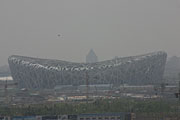- Number 355 |
- January 30, 2012
Weather deserves medal for clean air during 2008 Olympics

High smog levels, seen here
during the stadium's construction,
were a
concern before the
Olympic Games in Beijing in
2008. Regional weather
patterns and emission controls
reduced smog levels at the
Olympic Games. Photo courtesy
of Ry Tweedie-Cullen.
New research suggests that China's impressive feat of cutting Beijing's pollution up to 50 percent for the 2008 Summer Olympics had some help from Mother Nature. Rain just at the beginning and wind during the Olympics likely contributed about half of the effort needed to clean up the skies, according to DOE’s Pacific Northwest National Laboratory and the Chinese Academy of Sciences. The results also suggest emission controls need to be more widely implemented than in 2008 if pollution levels are to be reduced permanently.
The team took advantage of the emission controls China put into play before and during the games to study the relative contributions of nature and planning. Chinese officials restricted driving, temporarily halted pollution-producing manufacturing and power plants, and even relocated heavy polluting industries in preparation for the games.
To find out if the controls worked as well as people hoped, the researchers modeled the pollution and weather conditions in the area before, during and after the Olympics. They compared the model's results with measured amounts of pollution, which matched well.
[Kristin Manke, 509.372.6011,
kristin.manke@pnnl.gov]
